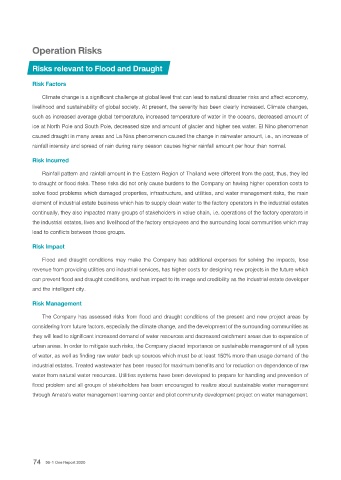Page 74 - Amata-one-report2020-en
P. 74
Operation Risks
Risks relevant to Flood and Draught
Risk Factors
Climate change is a significant challenge at global level that can lead to natural disaster risks and affect economy,
livelihood and sustainability of global society. At present, the severity has been clearly increased. Climate changes,
such as increased average global temperature, increased temperature of water in the oceans, decreased amount of
ice at North Pole and South Pole, decreased size and amount of glacier and higher sea water. El Nino phenomenon
caused draught in many areas and La Nina phenomenon caused the change in rainwater amount, i.e., an increase of
rainfall intensity and spread of rain during rainy season causes higher rainfall amount per hour than normal.
Risk Incurred
Rainfall pattern and rainfall amount in the Eastern Region of Thailand were different from the past, thus, they led
to draught or flood risks. These risks did not only cause burdens to the Company on having higher operation costs to
solve flood problems which damaged properties, infrastructure, and utilities, and water management risks, the main
element of industrial estate business which has to supply clean water to the factory operators in the industrial estates
continually, they also impacted many groups of stakeholders in value chain, i.e. operations of the factory operators in
the industrial estates, lives and livelihood of the factory employees and the surrounding local communities which may
lead to conflicts between those groups.
Risk Impact
Flood and draught conditions may make the Company has additional expenses for solving the impacts, lose
revenue from providing utilities and industrial services, has higher costs for designing new projects in the future which
can prevent flood and draught conditions, and has impact to its image and credibility as the industrial estate developer
and the intelligent city.
Risk Management
The Company has assessed risks from flood and draught conditions of the present and new project areas by
considering from future factors, especially the climate change, and the development of the surrounding communities as
they will lead to significant increased demand of water resources and decreased catchment areas due to expansion of
urban areas. In order to mitigate such risks, the Company placed importance on sustainable management of all types
of water, as well as finding raw water back up sources which must be at least 150% more than usage demand of the
industrial estates. Treated wastewater has been reused for maximum benefits and for reduction on dependence of raw
water from natural water resources. Utilities systems have been developed to prepare for handling and prevention of
flood problem and all groups of stakeholders has been encouraged to realize about sustainable water management
through Amata’s water management learning center and pilot community development project on water management.
74 56-1 One Report 2020

